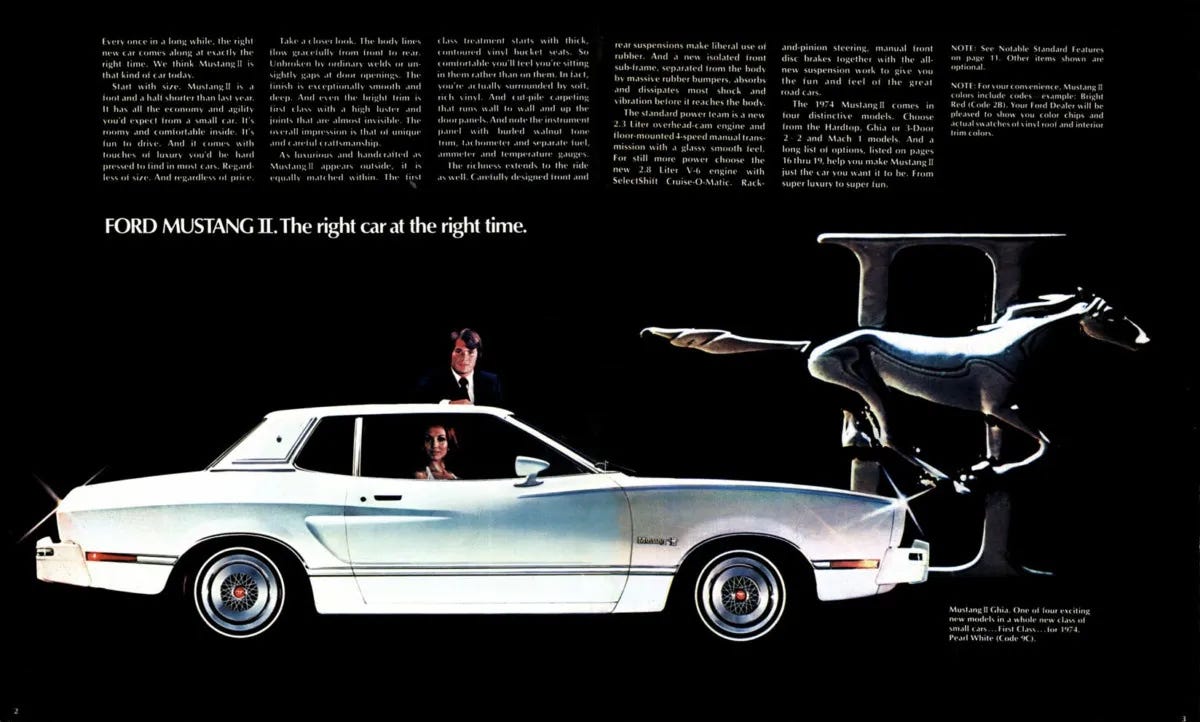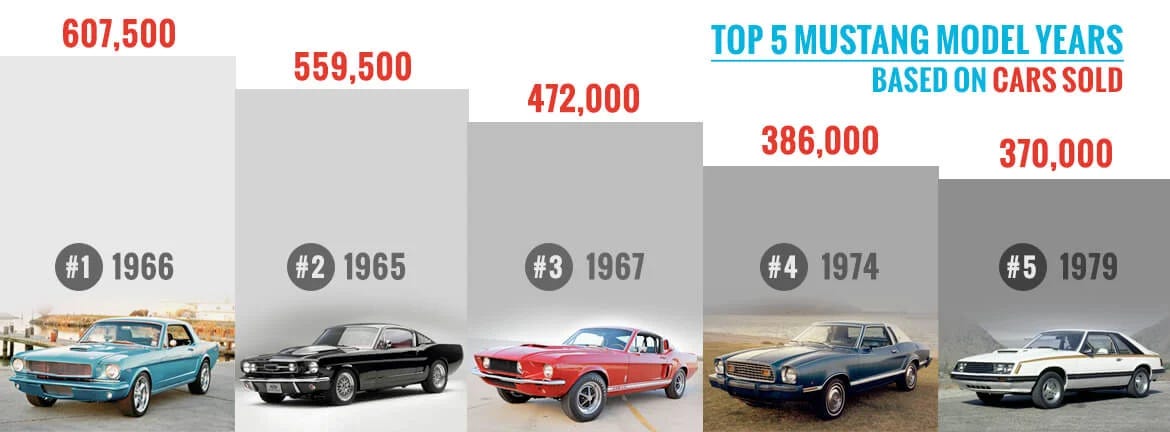Ford Needs A Mustang II, And They Need It Now
All subscribers welcome
Ford hasn’t been eager to publicize it, but 2024 was an utterly historic year for the Mustang. Not due to the arrival of a new range-topping Dark Horse, with its 500-horsepower Coyote coupled (finally!) to an unburstable Tremec 6-speed manual. Not because of the slightly embarrassing IMSA Mustang Challenge race series in which a bunch of goofy pay-drivers spent around million dollars a year, each, to turn worse lap times than my old Radical PR6 while also incompetently bumping each other into oblivion. (The principal of one well-known Ford-centric race team recently told me, regarding the Mustang Challenge, “It’s a great way to piss away on impressing… nobody.”) It wasn’t thanks to the all-American hero — alright, the all-Russian hero — who got drunk and rammed a total of eleven cars around his apartment complex before receiving some corrective action from local community organizers.
No, 2024 will have a special place in the Mustang history books for a very different reason: with just 47,212 units out the door, this was the worst model year in the nameplate’s six-decade history.
Second worst? 2022.
Third worst? 2021.
Fourth worst? 2023.
Fifth worst? 2020.
You get the idea. These numbers would have been dismal enough back when the Mustang was a fairly cheap-to-build platform relative to the Falcon, Pinto, or Fairmont. In 2025, when it is all but a bespoke device drawing on the mother company for little more than engines and electronics, that’s even worse news. Even the “Mustang” Mach-E electric hatchback outsells it — although that’s almost certainly due to an avalanche of sweetheart lease deals that make the Mach-E about half as expensive to own on a monthly basis than even the cheapest Ecoboost Fastback coupe.
This is not a sustainable state of affairs, even at the inflated transaction prices commanded by the V-8 trim levels. Something must be done — and Ford surely knows what to do, as do I. The answer is hidden in this lovely graphic from Mustang aftermarket vendor CJ Pony Parts:
For the sake of clarity, let’s bundle 1965, 1966, and 1967 into a single happening, and we can then see that all three Mustang sales highlights have a few aspects in common:
They represent the first year of a genuinely new and different body style. This is commonly the case in the auto business. People want the new car. With products that put enthusiast appeal front and center, that’s doubly true.
They didn’t necessarily have the best engines or the best performance. This is especially true for the 1974 Mustang, which had no V-8 option, and the 1979 Mustang, which had a broad but not necessarily good range of an indifferent 4-banger, a lousy straight-six, a soft V-6, a troublesome turbo four, and an underwhelming 302.
Affordability was front and center, while desirability was high. The majority of Sixties Mustangs were “secretary specials”, while the bulk of 1974 and 1979 Mustangs were powered by just four cylinders. Base models were popular. The versions we talk about today — the Shelbys, the Cobras, the GTs — were either unavailable or rare. Yet there was no shortage of buyer enthusiasm, because even the entry-level cars had charisma. (We call that “rizz” now.)
The car got smaller. The 1965 Mustang was smaller than the average family car. The 1974 Mustang was smaller than the 1973. The 1979 was lighter and more efficient than its predecessor.
Obviously, the 2025 Mustang comes up short when measured against the above. The current car might not be exactly the second facelift of the 2015 car, but it kind of comes off as just that. The “Dark Horse” cars aren’t particularly compelling the way the Shelby-badged SVT models were. Everything but the base Ecoboost car costs an astounding amount of money, and that car goes pretty much unadvertised and un-marketed. Ford’s practice of dumping Mustang convertibles to the rental-car companies has done significant harm to the desirability of everything beneath the Dark Horse… which is a two-ton monster of a vehicle. It’s a bad situation, and unlikely to get any better.
What to do? The “enthusiast” answer is to make the Mustang faster and/or more exciting, but history suggests it’s not an effective answer. That’s going to be doubly true in a challenging economy, and triply so given today’s insurance rates.
Alternately, the existing Mustang could be made cheaper, via product reshuffling, de-contenting, or production simplification — imagine a “Mustang America” using Lee Iacocca’s old playbook from the Horizon/Omni/TC3/024 America models. But you’ll still have a Mustang that is too big, too bulky, too unpleasant in foul weather, and possessed of some genuinely awful visibility for drivers under six feet tall.
We need a Mustang that is small, cheap, handsome, and easy to understand. Every time Ford has done this in the past, it has worked. Take a deep breath, and let’s ponder the following idea:
Ford needs a $24,999 Mustang II based on the Escape/Maverick/BroncoSport platform and motivated by your choice of hybrid or turbo engines. The form factor should be similar to the Honda HR-V, but it needs to look sportier. A manual transmission should be available, in the cheapest version. AWD should be an option.
Let’s address the objections.
It would be front-wheel-drive. Yes, it would. That’s okay. Today’s young drivers want that.
It would be slow. Also okay. Most Mustangs throughout history have been slow.
It would be more like a Focus than a Mustang. The Focus is gone, and — here’s the kicker — it mostly appealed to enthusiasts anyway. So the form factor is no barrier to enthusiasm.
It would besmirch the Mustang name, the way the original Mustang II did. Oh, you mean the car that saved the Mustang for future generations, and helped Ford, and made a lot of customers really, really happy? We can live with those consequences.
Ford can sweeten the pot for anyone who feels this way by keeping the current Mustang in production alongside the Mustang II, the same way the Bronco and Bronco Sport reinforce each other in the showroom. I suspect sales of the “real” Mustang might even go up a bit as a result. Some buyers will come into the showroom ready to spend thirty-five grand on a completely loaded Mustang II Turbo and find out they could actually get an Ecoboost Coupe instead. Right now most of those people are out buying something else entirely.
How would the Mustang II differentiate itself from the Escape and Bronco Sport? It would be smaller, cheaper, faster, and more fashion-forward. How could Ford keep the price at $24,999? By not giving it any more content than a base Maverick. What will the average transaction price be? Probably thirty-one or thirty-two grand. That tracks pretty well with how the 1974 and 1979 Mustangs were priced and positioned.
Development cost would be reasonable, as it amounts to a new “top hat” for the Escape and EPA certification for a manual transmission.
What should it look like? I think the Mach-E could be taken as a starting point, just make it lower, sleeker, and meaner. The back seat doesn’t have to be ultra-spacious. Let the roof drop.
You market it by calling back to 1965, by making sure that every ad shows the stick shift while also mentioning the automatic and hybrid, and by positioning it as a genuinely exciting alternative to the Chevy Trax. As with the Bronco Sport, there should be a near-limitless array of special editions, tape-and-stripe packages, wacky colors, and so on.
If the ex-SVT boys want to eventually cook up a Kona N competitor, kind of an alt-universe Focus RS, let them — but the initial focus is on unthreatening good times, period, point blank. Talk to the insurance companies. Get them on board. Figure out ways to make it a little cheaper to repair. Use the original Twingo as inspiration, along with the Ikea aesthetic. Cheap and cheerful and uncomplicated.
This, to a lesser extent, is what Ford’s already done with Bronco Sport, which has proven to be a massive success. You can make fun of the Bronco Sport for its lack of off-road prowess, its pathetic 3-cylinder engine, the oppressive Brutalist-avec-poverty feel of the interior. Nobody cares. They see that it’s fun and comes in fun colors and doesn’t cost $45,000, and that sells 130,000 units a year of something that is basically a de-contented Escape or a Maverick with a hatchback, take your pick.
I’ve saved the best part for last. If Ford can put 100,000-plus Mustang IIs on the road every year for five or six years, they will have created a whole demographic of people who have had fun in their Mustang IIs and might therefore be interested in adding a “real” Mustang to their garage as time and finances permit. This is the sort of thing that pays dividends decades down the line; if you don’t believe me, call your local Acura dealer and ask what discount they’re giving on the Integra Type S.
That’s right. The Mustang II could save the Mustang. Again.




Great article but one correction. The Dark Horse does not use an unburstable version of the Tremec. It uses the TR-3160, not the TR-6060.
The Tremec in the Dark Horse is a version of what GM uses in the V6 Camaro. It is a HUGE flaw and the main reason I did not purchase one. I ended up with a used SS 1LE instead.
RPM Transmissions, who built the TR-6060 in my Corvette, won't even touch the TR-3160.
They need to make something that isn't a stupid combover, a stupid EV or an F150.
I'd even welcome a Mustang sedan, if it means we get a Lincoln version.